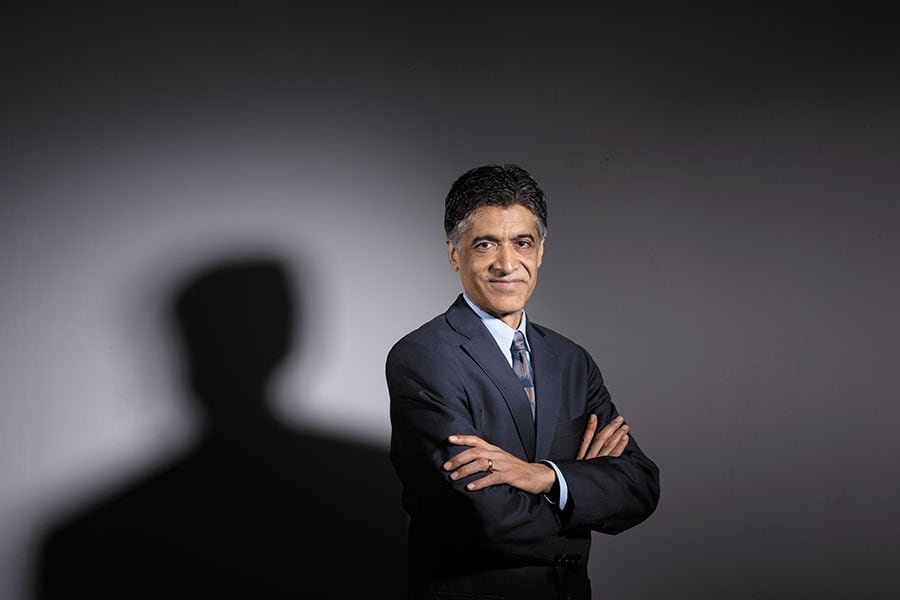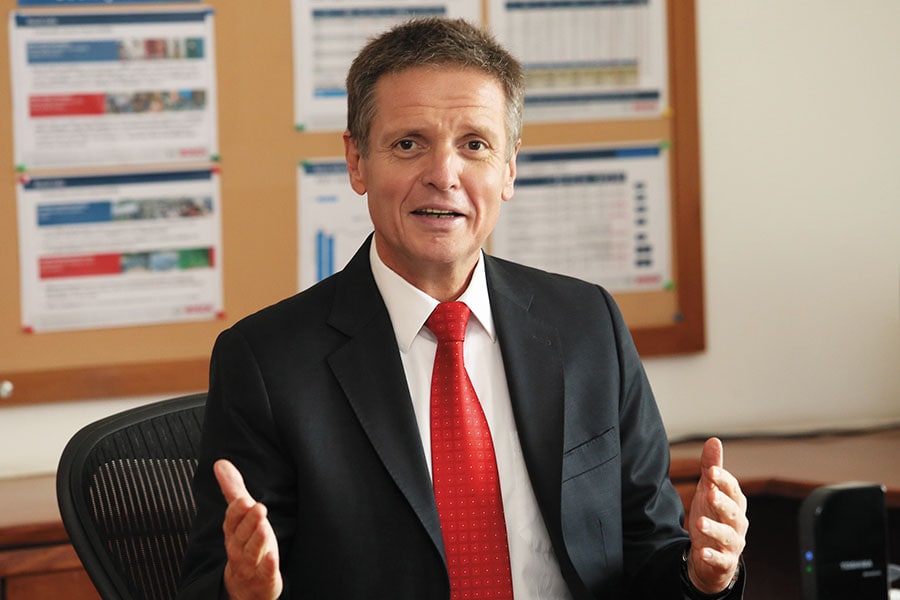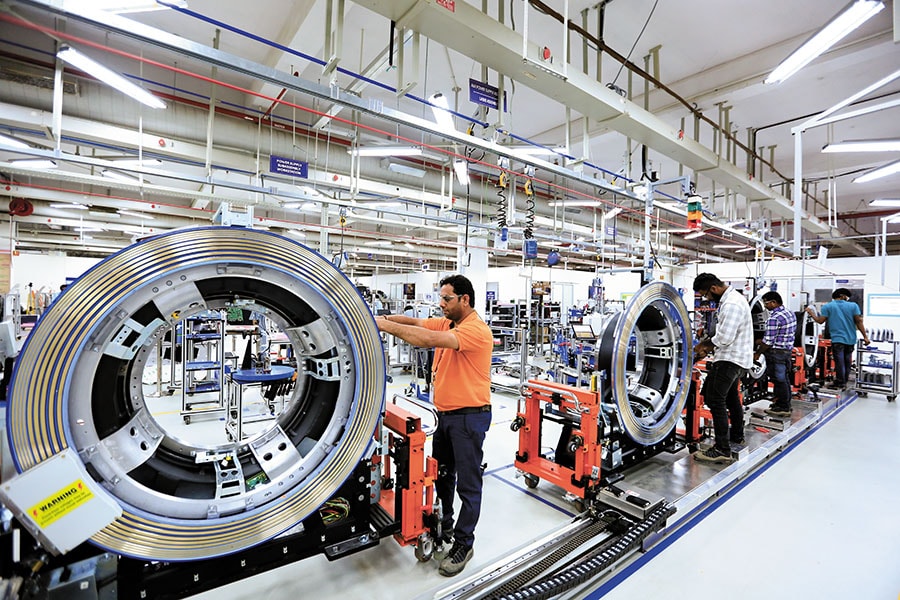
Reverse innovation: Made in India, for the world
Multinational giants like GE, Siemens and Bosch are mastering reverse engineering to take made-for-India products global
 Vishal Wanchoo, president and CEO, GE-South Asia, is full of praise for the talent in India
Vishal Wanchoo, president and CEO, GE-South Asia, is full of praise for the talent in India Image: Amit Verma
Four years ago, when the buzz around total rural electrification in the country gained momentum with the arrival of the Narendra Modi-led government, engineers at the Bengaluru premises of General Electric (GE) started to look for solutions. India, according to a September 2017 report by Reuters, has more than 40 million households that need to be electrified.
By the latter half of last year, the $120-billion American multinational had found a solution and began pilot projects of its Hybrid Distributed Power (HDP) system in two villages in the state of Bihar in North India. The project is in partnership with Tata Power—the service provider of electricity. Each village is home to approximately 1,000 people, who now get access to power for basic needs such as lighting up bulbs, running fans and charging mobile phones. There are no practical limits on what can be connected to the minigrid, says the company, as it is a function of how the operator (Tata Power) is limiting or charging for the load.
This, even as the politics of rural electrification has reached a crescendo with the opposition and the government quarrelling over how many rural households and villages have been electrified—the May 2017 deadline for electrifying all villages has been extended by a year.
GE’s HDP is a single integrated power system consisting of solar, battery and diesel power. The bulk of the electricity generation is through solar power. The batteries, which are charged through solar power, are switched on at night. The diesel component of the system acts as a backup, quite literally, for rainy days.
Depending on the power needs and population of the village, either a 15 kilowatt or 30 kilowatt HDP system can be installed. If the requirement is for 60 kilowatt, then two 30-kilowatt power systems can be used.
“The concept was that we can use a hybrid power system of solar, batteries and diesel. And the trick here from the innovation standpoint is to use analytics for remote monitoring and diagnostics. Another advantage is the ability to operate diesel in very low volume,” VishalWanchoo, president and CEO, GE-South Asia, tells Forbes India. “All this is made possible using GE’s Predix capability.” Predix, a global GE innovation, is an application platform designed for digital industrial Internet of Things solutions. To be sure, any innovation that happens in India does involve collaboration with other GE innovation centres across the world.
That said, the HDP innovation was carried out by GE’s India engineers based at the John F Welch Technology Centre (JFWTC) in Whitefield, Bengaluru. Set up in 2000, JFWTC is GE’s largest multidisciplinary research and development centre outside the US and is home to about 5,300 engineers and scientists.
The integration of different power sources and relying predominately on solar power meant lower tariffs. According to GE, Tata Power charges each household a fixed fee per month for a certain amount of power access. As the power systems are connectivity-enabled, it allows GE to remotely monitor and analyse data such as usage, charge and discharge of power and billing among other things.
And it’s just not India that needs this power solution. “A couple of systems have been installed in Ethiopia where we are powering medical facilities on the outskirts of the main towns. We have signed MoUs to supply a number of systems to Indonesia,” says Wanchoo. “We have also installed some systems in Australia as there was no grid availability of power for some of the remote mines. Since those mines were operating on diesel power, the benefit of this hybrid system makes economic sense out there as well.”
Since 2011, GE’s mantra in India has been to innovate on products and services that are relevant to the domestic market and then take those to global markets. In fact, it’s a concept being adopted by many US and European multinational companies in the country.
 “I know that more than 2,500 people [in India] are developing software solutions for Advance Parking Systems.”
“I know that more than 2,500 people [in India] are developing software solutions for Advance Parking Systems.” — Dr Andreas Wolf, joint MD, Bosch Limited
Vijay Govindarajan, Coxe Distinguished Professor at the Tuck School of Business at Dartmouth, terms it “reverse innovation”. He explains that reverse innovation has three stages: Innovate in India, for India; use those innovations to drive growth in other emerging markets; and take those innovations to developed countries.
In 2009, Govindarajan along with GE’s former CEO Jeff Immelt authored a Harvard Business Review article titled ‘How GE is Disrupting Itself’, where the concept of ‘reverse innovation’ was first spoken about. It was also the same time that GE’s current chairman and CEO John L Flannery took charge as head of GE India (2009 to 2013) and started to look at newer avenues to drive growth.
“That’s when this idea started of whether we could innovate in India on products and services that were more relevant to the Indian market,” says Wanchoo, who was then part of Flannery’s team at GE India. That journey has resulted in GE not only tasting success in India, but also in many markets that are similar to India.
One of its most successful products is the Revolution ACT scanner, an affordable CT scanner that is used for the diagnosis of trauma and stroke patients which was launched in 2015. Back then, “This kind of technology (CT scanner) was not available in tier 2 and tier 3 cities,” claims Wanchoo. Only the big hospitals in metros could afford to buy a CT scanner. So, while innovating on the Revolution ACT scanner price point was critical, the goal, says Wanchoo, was to build a product that would cost 40 to 50 percent less than a traditional CT scanner. Today, the company sells more than one Revolution ACT scanner per day in India, with annualised sales of over 400 units. About 150 units have been exported to countries like Vietnam and Indonesia.
Another product innovation is the Discovery IQ PET CT scanner used for early diagnosis of cancer. Also built at a price point that is significantly lower than what was available in the market, it has enabled GE become the biggest player in Molecular imaging in the country.
“Today, our affordable care portfolio is a $1.5-billion business, globally. About 10 percent of that business, through the product line, is done in India,” says Wanchoo.
Another India innovation that Wanchoo is excited about is the company’s latest product offering for onshore wind power generation. GE’s India engineers have developed a wind turbine that is capable of capturing and generating electricity at much lower wind speeds, of 7 metres per second and below. For this, the engineers had to create a product that had to be much taller, but modular in form so that it could be easily transported to remote site locations. And it had to have larger wind rotors to be able to generate electricity efficiently.
“In March 2017, we decided to put the full product ownership, completely end-to-end, in India. This was the first time we have done that. We appointed people who would run the full programme,” says Wanchoo. India, he says, will become the centre of excellence for designing and developing the product for markets like China, Vietnam, Pakistan and parts of Europe. The deployment of the product in India will begin next year.
*****

— James Brandt, MD, Lowe’s India
India’s prowess in software engineering is another innovation focus area for multinationals. Software that’s made in India is now the heart and soul of products that are sold worldwide.
In an article titled ‘India–A Country on the Rise’, Gerd Höefner, former head of the Siemens Corporate Development Center for software, in Bengaluru, remarked: “The days when Americans and Europeans viewed Indian software developers as cheap ‘coding slaves’ are long gone.”
Siemens’s syngo classic software, which is the platform for imagining systems that are manufactured by Siemens Healthcare, was developed at the company’s technology centre in Bengaluru. Germany-headquartered Siemens has around 6,000 software engineers in India spread across Bengaluru, Pune and Gurugram.
Recently, its India engineers played a key role in the design and development of two 3D-printed oil sealing rings that were to be installed on an industrial steam turbine owned by JSW Steel Ltd. “Siemens has set an innovation milestone by using AM (additive manufacturing) to produce a steam turbine replacement part. This precedence will further aid the use of AM for production of repair parts and its application globally,” says Prashant Jain, country division lead-power generation services division of Siemens India.
Then consider the 18,000-strong IT engineering workforce of another German multinational, Bosch. Started in January 1998, Robert Bosch Engineering and Business Solutions is the largest entity of Bosch in India. It is also the largest research and development centre for Bosch, outside of Germany.
“The reason that software is becoming increasingly important for us is because we are not only focusing on products and services, but also offering solutions for our customers,” says Dr Andreas Wolf, joint managing director, Bosch Limited.
As an example, the company’s telematic solution called iTraMS (intelligent transportation management system) was developed in India and has been implemented with an Indian original equipment manufacturer. The software allows fleet-owners to effectively manage their fleet—vehicles and aircraft.
“More than 2,500 people [in India] are developing software solutions for APS (Advance Parking Systems),” says Wolf. “A Mercedes or any other car, you would be surprised of how much software in it is developed in India.”
The Bosch engineers are also working on developing advanced software that would help reduce energy bills and lower carbon emissions as well as health care-related software solutions. In 2014, Bosch launched a locally-developed retinal eye screening camera that could detect conditions like diabetic retinopathy and glaucoma.
 The Revolution ACT scanner is manufactured at GE Healthcare’s facility in Bengaluru
The Revolution ACT scanner is manufactured at GE Healthcare’s facility in BengaluruIn India, there are two kinds of innovation centres, believes Lalit Ahuja, CEO, ANSR Consulting, which has helped global companies establish their GICs (Global In-house Centres or captive centres) in the country. “There are innovation centres like the GE kind where they are building products or solutions for solving specific problems. At the other extreme, there are innovation capabilities being set up to work on futuristic concepts,” says Ahuja.
Backed by venture capital firm Accel Partners, ANSR has set up 33 GICs in India across Bengaluru, Hyderabad and Mumbai since its inception in 2004. About ₹10,000 crore has been invested cumulatively by these GICs in India.
“The companies that are setting up GICs are not coming for cost arbitrage; they are coming here for other reasons such as to build strategic capacity so that they can drive their growth and transformation agenda, innovate, build new business capabilities, and build centres of excellence in areas like robotics and drone technology,” adds Ahuja.
So far it has largely been a wave of US and European multinationals such as JC Penney, Lowe’s, L Brands (the maker of the lingerie brand Victoria’s Secret), Anheuser-Busch InBev, the world’s largest brewer, that have set up GICs in India. However, in recent times South American and Australia companies have begun establishing their presence. “We are talking to companies in Hong Kong and China, so the trend is catching on,” says Ahuja.
In February 2016, the $68.6-billion American home improvement company Lowe’s set up its innovation lab in Bengaluru. “While our initial intent of the Lowe’s Innovations Labs was to look at futuristic technologies such as augmented reality, virtual reality, robotics and 3D printing, we have expanded our scope into data sciences as well,” says James Brandt, managing director, Lowe’s India.
The company’s approach to innovation is to engage with the startup ecosystem to identify opportunities, develop proofs of concept and deploy new technologies in the US market. It has launched a startup engagement programme called Collider. “We are working closely with a few startups and will be happy to share a few success stories in the future,” says Brandt.
Two years ago, as part of its health care division, GE India launched an innovation fund five.eight (the name refers to the estimated 5.8 billion people in the world who lack access to quality, affordable health care) with an aim to engage with startups. The fund would invest up to $5 million per startup and not just in Indian startups, but also global ones who are looking to innovate in India.
“We are here purely for the talent and the capabilities that will enable the future growth of a $68.6-billion home improvement business,” says Brandt. Wanchoo concurs. “If you think about our Global Research Centre in Bengaluru, it is one of two such centres for GE in the world. So that gives you the flavour of how we see the tremendous talent in this country,” says Wanchoo. He adds: “We actually have an analytics factory, which does data analytics across all verticals, for the world [for GE] led out of Bengaluru, which is a huge statement.”
(This story appears in the 11 May, 2018 issue of Forbes India. To visit our Archives, click here.)
X














